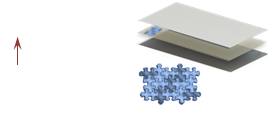
With the change of anti-polution legislation (broad concept accounting for noise pollution), the transportation industry aims to decrease the weight of their vehicules. With this goal in mind, new innovative material’s solutions are envisioned in replacement for standard metallic compounds. Ultimately, two conditions need to be fulfilled: the materials solution needs to preserve the mechanical integrity (stiffness, strength) of the structure yet providing remarkable damping performance for both vibration and acoustic transfer. Among the successful routes investigated, the use of sandwich hybrid composite materials with two external metallic skins and a polymeric core combines good performance on both metrics, at first considered antagonist.
Lately, co-workers developed a process using UV radiation in order to trigger the mechanical properties of silicone elastomers (Young’s modulus and damping). Furthermore, with the use of masks positioned between the UV source and the monomers, the UV dose, and thus the crosslink density of the macromolecular network is spatially altered, so that architectured silicone membrane with special properties can be easily processed (material by design). Ultimately, inserting such architectured
membrane within metallic skins offers new perspective in terms of vibro-acoustic performance optimization, as well as an easy route to deal with exotic applications such as “vibration trap”, or viscous monomers encapsulation with a solid polymer frame.
With this work, we aim to finalize recent effort on the architecturation of silicone membrane and the adhesion of silicone material with metallic materials. Special care will be devoted to that characterization of the interface layer since they can contribute to the overall damping performance. Second, the effect of the architecturation of the polymeric core on the composite performance needs to be investigated: vibration measurements over a wide frequency range will be pursued. Finally, the innovative process based on the in-place architecturation of the polymeric membrane will help developing new applications.

